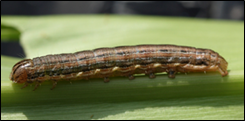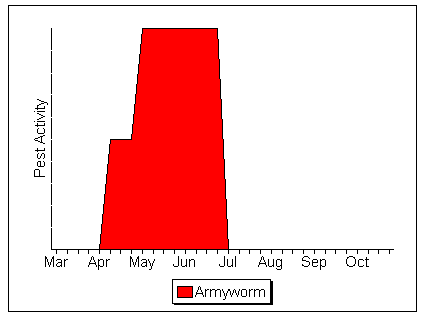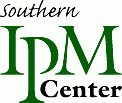Armyworm in Wheat
Armyworm
Description

Armyworm
University of Kentucky Dept. Entomology
Larvae of the true armyworm are greenish brown with a narrow, mid-dorsal stripe and two orange stripes along each side. The yellowish head of the larva is honeycombed with dark lines. Armyworm larvae are about 1.5 inches long when full grown. Pupation occurs in the soil. Adult moths are nocturnal with a small, white dot in the center of each wing.
Damage
Armyworms generally appear in Kentucky wheat from mid-April to late May. In wheat, populations reach economic levels in late May and early June. Heavy damage is seen when late instar larvae begin clipping off seed heads. The larvae are most often found in luxuriant or lodged vegetation in low wet areas, and cool, wet springs will favor armyworm development. Armyworms are primarily leaf feeders; however, they will feed on awns and tender kernels. Other hosts of armyworms include corn, bluegrass, oats, rye,and some forages.
Armyworm Activity in Wheat

Please note: These dates are approximations only. This calendar was constructed using data from Kentucky, USA. These dates may not apply in your area. You may wish to contact your county extension agent or agricultural consultant for information tailored to your locality.
IPM Techniques and Scouting Procedures
- Scouting is recommended in Kentucky from mid-April through harvest on a weekly basis.
- Field margins and lodged grain should be checked first. If armyworms are present, begin sampling the standing grain.
- Enter the field at least 30 paces before sampling. Check leaves for signs of damage and examine the ground for dark fecal droppings. Armyworms feed during late afternoon, night and early morning, starting at the edge of a leaf and feeding in towards the midrib. During the day armyworms will often hide under surface litter or in soil cracks.
- Five sites should be sampled for each 50 acres of field size. Select sample sites so that the entire field is covered. Use a 4 foot X 4 foot square to sample each site. You will want to record the number of armyworms present in each 4 X 4 area and the average length of the armyworms. The economic threshold is an average of 16 1/2-inch to 3/4-inch long armyworms per four square foot sample.
- Worms longer than 1 inch will do little damage. If the grain is nearly mature and no head clipping has occurred, then controls are not advised.
References and Additional Information
- IPM-4 Kentucky IPM Manual for Small Grains
- Entfact-111 Armyworms in Small Grains


